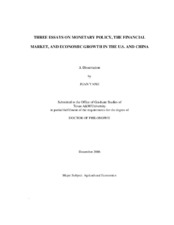| dc.contributor.advisor | Leatham, David | |
| dc.creator | Yang, Juan | |
| dc.date.accessioned | 2010-01-14T23:59:58Z | |
| dc.date.accessioned | 2010-01-16T01:35:19Z | |
| dc.date.available | 2010-01-14T23:59:58Z | |
| dc.date.available | 2010-01-16T01:35:19Z | |
| dc.date.created | 2006-12 | |
| dc.date.issued | 2009-05-15 | |
| dc.identifier.uri | https://hdl.handle.net/1969.1/ETD-TAMU-1030 | |
| dc.description.abstract | Does monetary policy affect the real economy? If so, what is the transmission mechanism or channel through which these effects occur? These two questions are among the most important and controversial in macroeconomics. This dissertation presents some new empirical evidence that addresses each question for the U.S. and Chinese economies. Literature on monetary transmission suggests that the monetary policy can take effect on the real economy through several ways. The most noteworthy one is credit channels, including the bank lending channel and the interest channel. First, I use a new method to test for structural breaks in the U.S. monetary policy history and present some new empirical evidence to support an operative bank lending channel in the transmission mechanism of monetary policy. Results show that an operative bank lending channel existed in 1955 to 1968, and its impact on the economy has become much smaller since 1981, but it still has a significant buffering effect on output by attenuating the effect of the interest channel. Second, I adopt the recently developed time series technique to explore the puzzling negative correlation between output and stock returns in China currently, and posit that it is due to a negative link between monetary policy and stock returns when monetary policy increases output. The monetary policy has not been transmitted well in the public sector which is the principal part of Chinese stock market, and increased investment capital from monetary expansion goes to real estate sector instead of the stock market. Last, I demonstrate how monetary policy has been transmitted into the public and private sectors of China through the credit channel. The fundamental identification problem inherent in using aggregated data that leads to failure in isolating demand shock from supply shock is explicitly solved by introducing control factors. I find that the monetary policy has great impact on private sector rather than public sector through credit channel in China. These findings have important practical implications for U.S. and China’s economic development by improving the efficiency of the monetary policy because a comprehensive understanding of monetary transmission will lead to better policy design. | en |
| dc.format.medium | electronic | en |
| dc.format.mimetype | application/pdf | |
| dc.language.iso | en_US | |
| dc.subject | monetary transmission | en |
| dc.subject | bank lending channel | en |
| dc.subject | interest channel | en |
| dc.subject | error correction model | en |
| dc.subject | directed graph | en |
| dc.subject | SUP-LM test | en |
| dc.subject | stock market | en |
| dc.subject | real estate sector | en |
| dc.title | Three essays on monetary policy, the financial market, and economic growth in the U.S. and China | en |
| dc.type | Book | en |
| dc.type | Thesis | en |
| thesis.degree.department | Agricultural Economics | en |
| thesis.degree.discipline | Agricultural Economics | en |
| thesis.degree.grantor | Texas A&M University | en |
| thesis.degree.name | Doctor of Philosophy | en |
| thesis.degree.level | Doctoral | en |
| dc.contributor.committeeMember | Bessler, David | |
| dc.contributor.committeeMember | Fraser, Donale | |
| dc.contributor.committeeMember | Klinefelter, Danny | |
| dc.type.genre | Electronic Dissertation | en |
| dc.type.material | text | en |
| dc.format.digitalOrigin | born digital | en |


